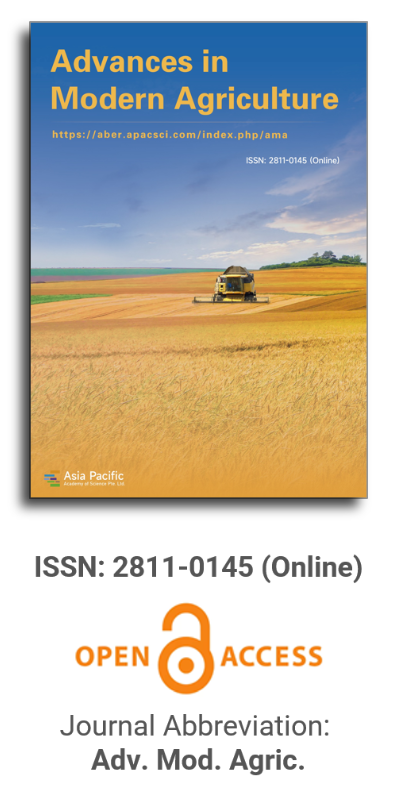


Efficacy of different irrigation methods in saving water and ameliorating pollution in paddy field: Take Pinghu as an example
Vol 1, Issue 1, 2020
VIEWS - 8273 (Abstract)
Download PDF
Abstract
Objective: Improving water use efficiency and ameliorating pollution is a challenge facing agriculture, and this paper aims to present an experimental study on the efficacy of different irrigation methods in saving water and reducing pollution in paddy fields in an attempt to provide suitable management for paddy fields in plain regions. Method: We examined three irrigation methods: flooding irrigation, shallow-water irrigation, and rain-collecting irrigation in Pinghu, Zhejiang province. For each irrigation, we measured TN, TP, NH4+-H, NH3-N, and COD in both irrigation water and drainage water. Result: Compared with flooding and shallow-water irrigation, rain-collecting irrigation reduced the amount of irrigation water by 67.4% and 43.4%, TN loss by 86.9% and 90.7%, emissions of NH4+-H by 96.7% and 98.3%, and COD emissions by 61.5% and 62.5%, respectively. The difference in change of TP and NH3-N between all three irrigation methods was not significant. Conclusion: For the areas we studied, rain-collecting irrigation is most effective in saving water and reducing pollution.
Keywords
References
- 2016 Jiaxing City Water Resources Bulletin (Chinese). Available online: https://zjjcmspublic.oss-cn-hangzhou-zwynet-d01-a.internet.cloud.zj.gov.cn/jcms_files/jcms1/web3028/site/attach/0/2a6fd7a8a00648c390054ba0dbe0e30b.pdf (accessed on 6 March 2020).
- Yang B, Chen X, Zhang Y, et al. The application analysis of the application of rice waters in Taihu Basin (Chinese). China Water Conservancy 2018; 7: 55–57.
- Ye S, Wu Z, Sun Z, et al. Strengthen agricultural water saving management and reduce rural surface source pollution (Chinese). China Water Conservancy 2012; 11: 27–29.
- Mao Z. Rice water-saving irrigation plays an important role in water saving, increasing yield and preventing pollution (Chinese). China Water Resources 2009; 21: 11–12.
- Wan Y. Research on rice fields based on water-saving irrigation mode (Chinese). China Rural Water Conservancy and Hydropower 2012; 5: 42–44.
- Xu J. Study on the Physiological Growth Response Mechanism of Water-Saving Controlled Irrigated Rice (Chinese) [PhD thesis]. Hohai University; 2007.
- Tao M, Yu S, Ye X. The impact of water level regulation on the farmland on rice root system (Chinese). China Rural Water and Hydropower 2014; 10: 73–75.
- Lv L, Feng C, Cui Y. The water utilization efficiency of different water-saving irrigation modes of rice: Take Jingmen and Guilin as an example (Chinese). Water Saving Irrigation 2011; 3: 15–17.
- Mao Z. Water-saving irrigation of rice and its impact on the environment (Chinese). Engineering 2002; 7: 8–16.
- Shao D, Qiao X, Liu H, et al. Different irrigation and row regulatory modes under the mode of water loss (Chinese). Wuhan University Study Journal (Engineering Edition) 2010; 3(4): 409–413.
- Zhou J, Su B, Huang N, et al. The study of rice farmers pollution in different irrigation modes (Chinese). Environmental Science 2016; 37(3): 963–969.
- Xiao W, Jia H, Qiu X, et al. The impact of rice irrigation of rice on rice fields on rice fields (Chinese). Journal of Irrigation and Drainage 2017; 36(11): 36–40.
- Chi J, Zheng E, Ke H, et al. Zhejiang Province Single-quarter rice-saving irrigation test research (Chinese). Journal of Irrigation and Drainage 2007; 26(3): 23–26.
- Jiang P, Yuan Y, Zhu R, et al., Water-saving irrigation conditions The characteristics of rice field runoff and leak loss features (Chinese). Journal of Agricultural Environment Sciences 2013; 32(8): 1592–1596.
- Chen Z, Guo X, Yao J. The water-saving effect of water storage and irrigation of rice (Chinese). Journal of Hohai University (Natural Science Edition) 2011; 39(4): 426–430.
- Guo Y, Guo X, Fan J, et al. Effects of water storage and irrigation control mode on rice yield and water production efficiency (Chinese). Journal of Irrigation and Drainage 2010; 29(3): 61–63.
- Guo X, Wang F, Wang Z, et al. Effects of different irrigation modes on chlorophyll fluorescence characteristics and yield of rice after heading (Chinese). Journal of Irrigation and Drainage 2017; 36(3): 1–6.
- Guo X, Yuan J, Guo F, et al. Rice water storage-controlling technology initial exploration (Chinese). Transactions of the Chinese Society of Agricultural Engineering 2009; 25(4): 70–73.
- Xie S, Sun X, Zou D, et al. Research on water-saving and emission reduction effects of rice fertilizer management technology in the northern cold area (Chinese). Water Saving Irrigation 2018; 5: 44–47.
- Yu S, Li C, Gao S, et al. Effects of controlled irrigation and drainage mode on water saving, high yield, emission reduction and pollution control in rice (Chinese). Transactions of the Chinese Society of Agricultural Engineering 2018; 34(7):128–136.
- Ye Y, Liang X, Zhou K, et al. Effects of water-saving irrigation and controlled release fertilizer application on soil nitrogen leakage and loss in Taihu Lake, China (Chinese). Acta Scientiae Circumstatiae 2015; 35(1):270–279.
- Li R, Xia Y, Wu A, et al. Water saving irrigation and nitrogen leaching of rice in Taihu Lake area (Chinese). Journal of Hohai University (Natural Science Edition) 2001; 29(2): 21–25.
- Yang R, Tong J, Li J, et al. Numerical simulation and leaching rule of surface runoff nitrogen loss in paddy field (Chinese). Journal of Irrigation and Drainage 2018; 37(1):63–69.
- Zheng S, Chen X, Zhang Z. Effects of thin dew irrigation on water quality of rice (Chinese). China Rural Water Conservancy and Hydropower 2005(3): 7–8.
- Gao H, Peng S, Mao Z, et al. Regularities of nitrogen and phosphorus loss in paddy drainage under different irrigation and drainage patterns (Chinese). Water Saving Irrigation 2009; 9: 1–3.
- Gao S, Yu S, Wang M, et al. Effects of controlled irrigation on water saving and nitrogen and phosphorus emission reduction in paddy fields under alternating drought and flood (Chinese). Transactions of the Chinese Society of Agricultural Engineering 2017; 33(5): 122–128.
- Ye Y, Liang X, Li L, et al. Effects of different water and fertilizer management on phosphorus runoff and leakage loss in rice fields in Taihu Lake Basin (Chinese). Acta Scientiae Circumstatiae 2015; 35(4): 1125–1135.
Supporting Agencies
Copyright (c) 2020 Yi Xu, Yongxiang Wu, Gaoxu Wang, Pei Liu, Ting Guo

This work is licensed under a Creative Commons Attribution 4.0 International License.

This site is licensed under a Creative Commons Attribution 4.0 International License (CC BY 4.0).

Prof. Zhengjun Qiu
Zhejiang University, China

Cheng Sun
Academician of World Academy of Productivity Science; Executive Chairman, World Confederation of Productivity Science China Chapter, China
Indexing & Archiving
In the realm of modern agriculture, the integration of cutting-edge technologies is revolutionizing the way we approach sustainable farming practices. A recent study published in Advances in Modern Agriculture titled "Classification of cotton water stress using convolutional neural networks and UAV-based RGB imagery" has garnered significant attention for its innovative approach to precision irrigation management. Conducted by researchers from Institute of Data Science and the AgriLife Research and Extension Center of Texas A&M University (authors's information is below). This study introduces a novel method for classifying cotton water stress using unmanned aerial vehicles (UAVs) and convolutional neural networks (CNNs), offering a powerful solution for optimizing water use in agriculture.
Modern agricultural technology is evolving rapidly, with scientists collaborating with leading agricultural enterprises to develop intelligent management practices. These practices utilize advanced systems that provide tailored fertilization and treatment options for large-scale land management.
This journal values human initiative and intelligence, and the employment of AI technologies to write papers that replace the human mind is expressly prohibited. When there is a suspicious submission that uses AI tools to quickly piece together and generate research results, the editorial board of the journal will reject the article, and all journals under the publisher's umbrella will prohibit all authors from submitting their articles.
Readers and authors are asked to exercise caution and strictly adhere to the journal's policy regarding the usage of Artificial Intelligence Generated Content (AIGC) tools.
Asia Pacific Academy of Science Pte. Ltd. (APACSCI) specializes in international journal publishing. APACSCI adopts the open access publishing model and provides an important communication bridge for academic groups whose interest fields include engineering, technology, medicine, computer, mathematics, agriculture and forestry, and environment.



.jpg)
.jpg)

.jpg)
